Lots of Wheels
Comment via blog
Prev
Next


|
Day 3: September 18, 2021 Lots of Wheels Comment via blog |
Prev Next |
 
|
|
|
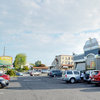 Once Dave Reese knew where I was staying, he suggested the
Sunrise Diner for breakfast. It was certainly
convenient for me and it was a short drive from there to
America On
Wheels after we'd eaten. Dave volunteers at the museum and his
personal guidance on
my previous
visit undoubtedly has a lot to do with why I think so highly of it. I
would have gone to the museum today even if Dave had been busy (Which was
a possibility.) but I know I would not have gotten half as much out of it.
Once Dave Reese knew where I was staying, he suggested the
Sunrise Diner for breakfast. It was certainly
convenient for me and it was a short drive from there to
America On
Wheels after we'd eaten. Dave volunteers at the museum and his
personal guidance on
my previous
visit undoubtedly has a lot to do with why I think so highly of it. I
would have gone to the museum today even if Dave had been busy (Which was
a possibility.) but I know I would not have gotten half as much out of it.
|
|
|
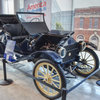
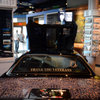 This visit started with a couple of cars in the lobby that weren't here
the last time I was. The 1914 Metz was donated in 2017. One of its claims
to fame was a cork based friction drive system that the company boasted
would last "3,500 - 5,000 miles" under normal conditions. The
Corvette was donated this year. Included in the impressive artwork that
covers it are the names of every victim of the 9-11-01 terrorist attacks.
This visit started with a couple of cars in the lobby that weren't here
the last time I was. The 1914 Metz was donated in 2017. One of its claims
to fame was a cork based friction drive system that the company boasted
would last "3,500 - 5,000 miles" under normal conditions. The
Corvette was donated this year. Included in the impressive artwork that
covers it are the names of every victim of the 9-11-01 terrorist attacks.
|
|
|
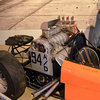
 Dave caught me studying this dragster which I thought rather interesting.
At first glance, it looked like a fairly modern rear-engine
"slingshot" but a second glance told me it was too short and the
engine was in sideways. The sign beside it
states that it was built by Lowell Lister in 1960. That's ten years before
legend has the exploding transmission in a front-engine dragster prompting
Don Garlits -- and eventually the world -- switching to rear engines. Of
course, there's more to the story and more behind the switch than one
explosion. Could the fact that Lister went to work for Garlits in the late
1960s have anything to do with it?
Dave caught me studying this dragster which I thought rather interesting.
At first glance, it looked like a fairly modern rear-engine
"slingshot" but a second glance told me it was too short and the
engine was in sideways. The sign beside it
states that it was built by Lowell Lister in 1960. That's ten years before
legend has the exploding transmission in a front-engine dragster prompting
Don Garlits -- and eventually the world -- switching to rear engines. Of
course, there's more to the story and more behind the switch than one
explosion. Could the fact that Lister went to work for Garlits in the late
1960s have anything to do with it?
|
|
|


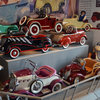
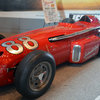

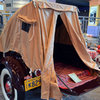 Variety is an important aspect of a museum and AOW has it. This
variety-pack panel starts with an 1830 Studebaker. It's a carriage which
is what the Studebakers built before tackling cars. The 1889 Nadig is
probably the most significant automobile in the museum. It seems like
a legitimate candidate for the first gasoline internal combustion powered
car built in America. That sign between its wheels can be better seen
here, its creation story read
here, and its history read
here.
Variety is an important aspect of a museum and AOW has it. This
variety-pack panel starts with an 1830 Studebaker. It's a carriage which
is what the Studebakers built before tackling cars. The 1889 Nadig is
probably the most significant automobile in the museum. It seems like
a legitimate candidate for the first gasoline internal combustion powered
car built in America. That sign between its wheels can be better seen
here, its creation story read
here, and its history read
here.
Almost everybody likes pedal cars and I can't imagine anyone not liking that little "woodie" at lower right. Number 88 is an Indy roadster from the late 1950s. That's a Flying Merkle between the Excelsior and a motorcycle I failed to identify. Although his own trailers keep getting bigger, a friend is something of an expert on small camping trailers and even runs a website devoted to them. There's no doubt that this 1936 Mullins with tent option would qualify. Especially when closed. |
|
|
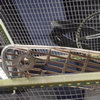


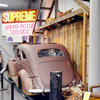 The exhibit on restoration was new to me and something I thought very
interesting. The coolest displays may have been the bits show the various
steps of repainting and rechroming. The one on rechroming came with
an explanation. Actually, the repainting one
did too but I didn't get a picture. There are, of course, plenty of extra
parts laying around to make the exhibit look authentic but some of those
parts have stories, too. For example, that grill is the one that Dave
replaced in his Triumph TR3.
The exhibit on restoration was new to me and something I thought very
interesting. The coolest displays may have been the bits show the various
steps of repainting and rechroming. The one on rechroming came with
an explanation. Actually, the repainting one
did too but I didn't get a picture. There are, of course, plenty of extra
parts laying around to make the exhibit look authentic but some of those
parts have stories, too. For example, that grill is the one that Dave
replaced in his Triumph TR3.
|
|
|
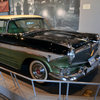

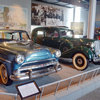
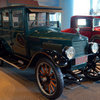
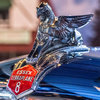 A cluster of Hudsons make up one of the museum's temporary exhibits. The
three-tone hardtop is from Hudson's last model year, 1957. Thirty years
earlier, the company was going strong when it built the 1927 Essex
Speedabout. Boat-tail roadsters aren't something I usually associate with
Hudson but this one is quite the looker. The pair in the third picture are
a 1954 Super Jet and a 1935 Custom 8. The Jet could have made Hudson a
leader in the compact market but it instead led to the merger with
Nash-Kelvinator and the company's ultimate demise.
A cluster of Hudsons make up one of the museum's temporary exhibits. The
three-tone hardtop is from Hudson's last model year, 1957. Thirty years
earlier, the company was going strong when it built the 1927 Essex
Speedabout. Boat-tail roadsters aren't something I usually associate with
Hudson but this one is quite the looker. The pair in the third picture are
a 1954 Super Jet and a 1935 Custom 8. The Jet could have made Hudson a
leader in the compact market but it instead led to the merger with
Nash-Kelvinator and the company's ultimate demise.
The green 1919 Essex represents the first year for the lower priced line of Hudsons. It took access, equipment, and skill to get the photo of the 1933 Essex Terraplane hood ornament. I thought the ornament was unusual and made an attempt to capture it. Dave, as a museum associate stepped behind the barrier and captured it from the other side. The angle required access and better equipment helped, but the real key was Dave's skill. Nice work. |
|
|
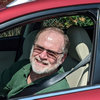
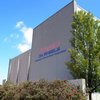
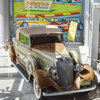 All three of these are catch-up shots of some sort. The 1933 Huppmobile
is right by the entrance and I started to photograph it when we first
arrived but decided to wait until I could get it from the front with the
AOW artwork behind it. The car was designed by Raymond Loewy of Studebaker
fame.
All three of these are catch-up shots of some sort. The 1933 Huppmobile
is right by the entrance and I started to photograph it when we first
arrived but decided to wait until I could get it from the front with the
AOW artwork behind it. The car was designed by Raymond Loewy of Studebaker
fame.
In 2012, I arrived at the museum a little ahead of Dave and grabbed a shot of the building before he got there. Then I got a shot of him in the parking lot. Today, I walked to the front of the building for a picture as we exited. I was actually pulling out when I realized that I had no picture at all of Dave and reached him just in time. A genuine snapshot. |
|
|
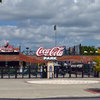
 Coco-Cola Park, home of the Lehigh Valley IronPigs, had come up in conversation a
couple of times so I decided to do a drive by. Apparently Martin Guitars,
in nearby Nazareth, PA, is a sponsor.
Coco-Cola Park, home of the Lehigh Valley IronPigs, had come up in conversation a
couple of times so I decided to do a drive by. Apparently Martin Guitars,
in nearby Nazareth, PA, is a sponsor.
|
|
|
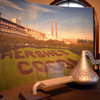
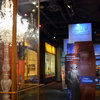

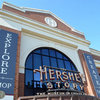 I reached Hershey a little early for check-in so decided to take in the
museum. It tells the story of Milton Hershey, the company he founded, and
the city he founded to support that company. That city was a little
different than most company towns and continues to thrive today. The
museum is interesting but not exciting. The closest it comes to the long
gone factory tours lamented by many is a retired "kiss" making
machine pretending to make and wrap Hersey Kisses.
I reached Hershey a little early for check-in so decided to take in the
museum. It tells the story of Milton Hershey, the company he founded, and
the city he founded to support that company. That city was a little
different than most company towns and continues to thrive today. The
museum is interesting but not exciting. The closest it comes to the long
gone factory tours lamented by many is a retired "kiss" making
machine pretending to make and wrap Hersey Kisses.
|
|
|
| [Prev] [Site Home] [Trip Home] [Contact] [Next] |